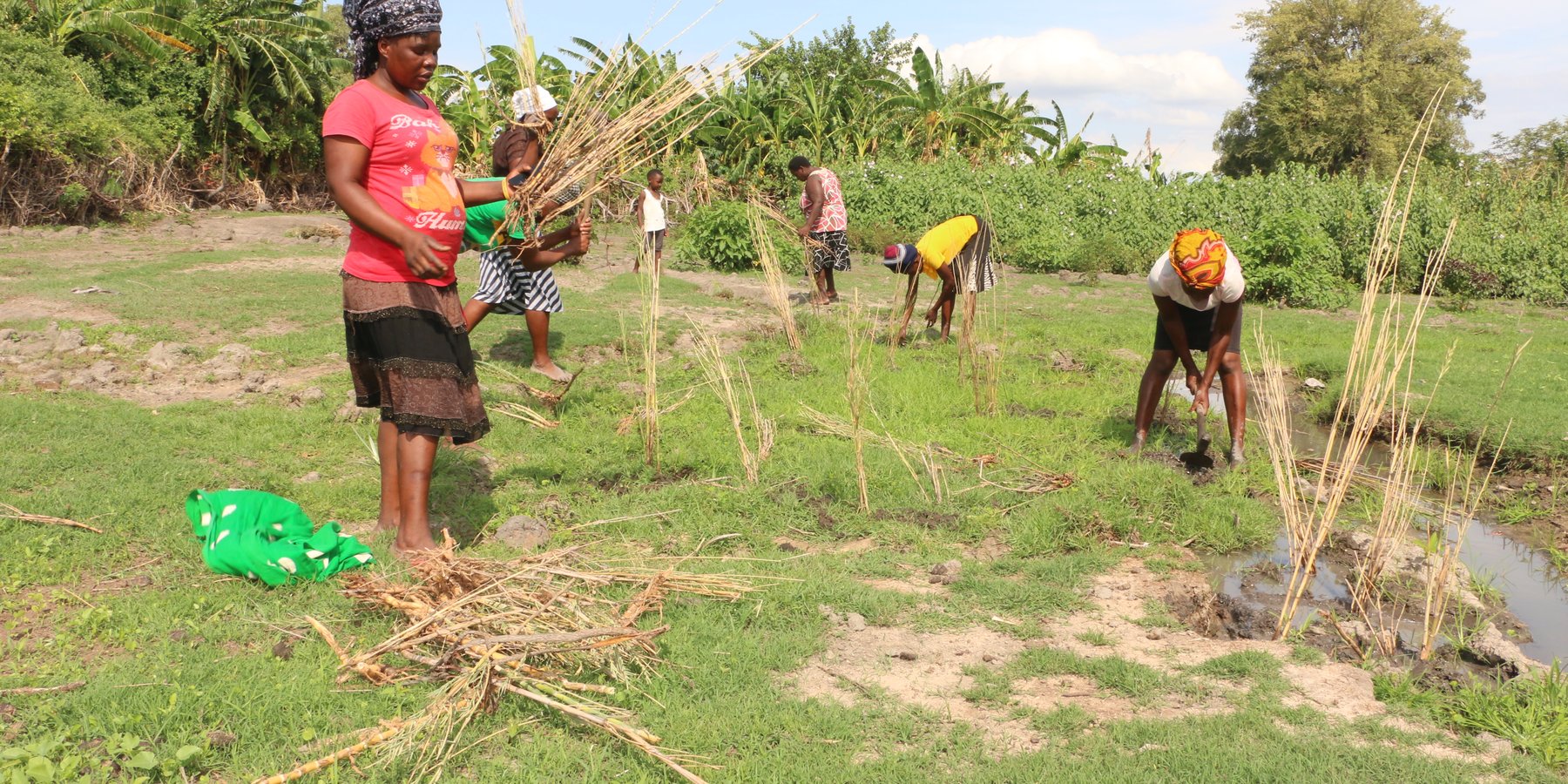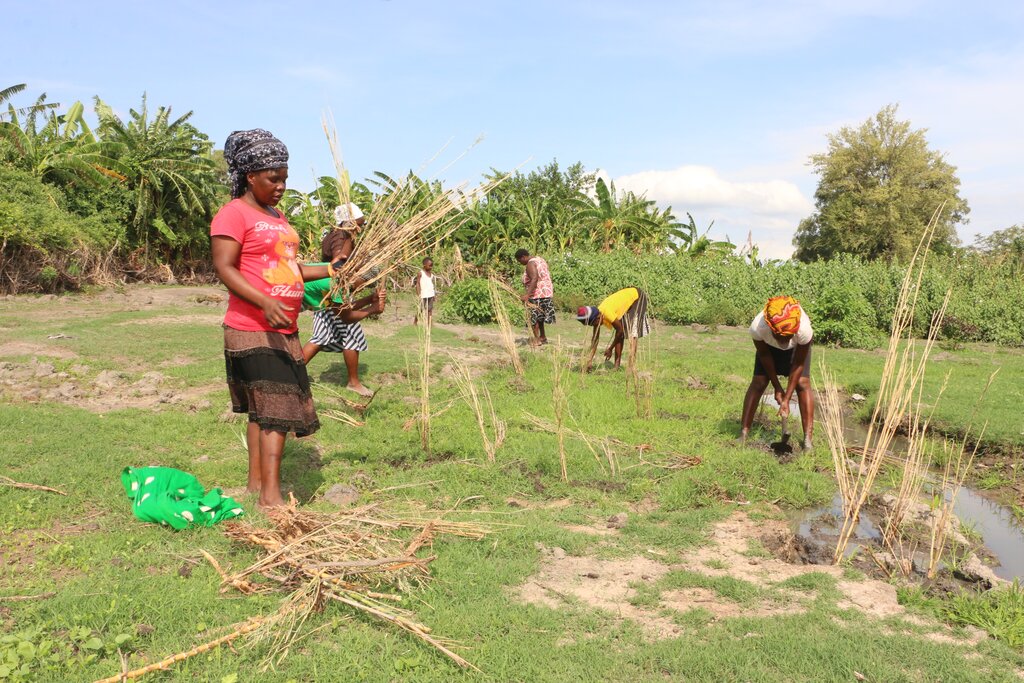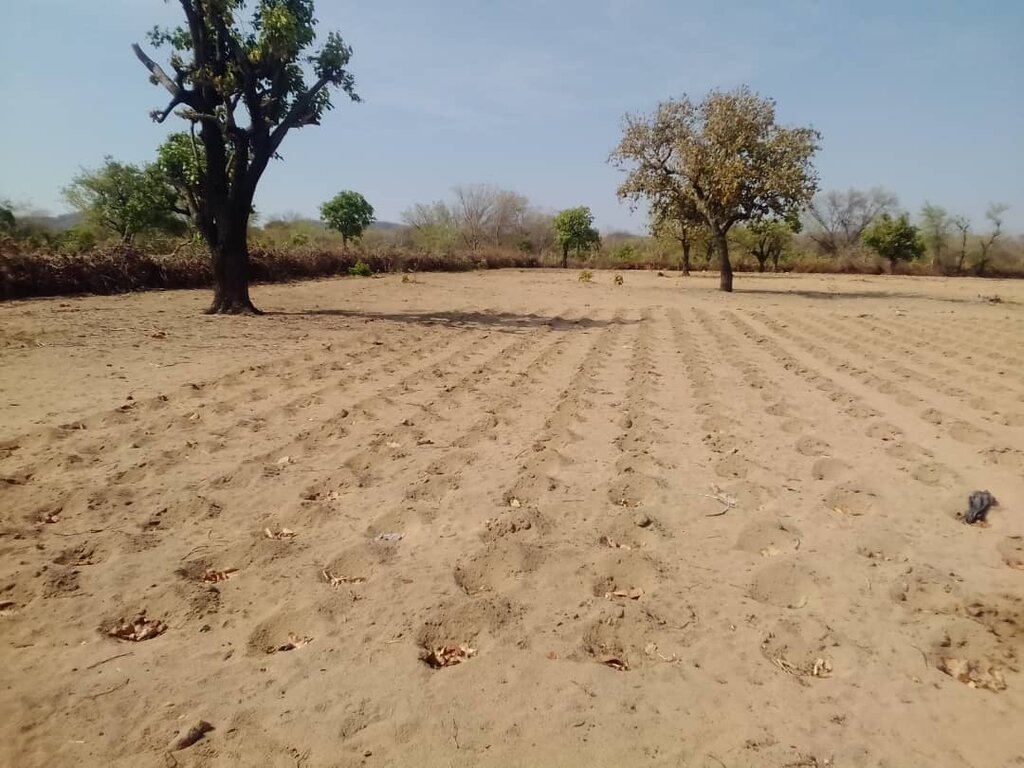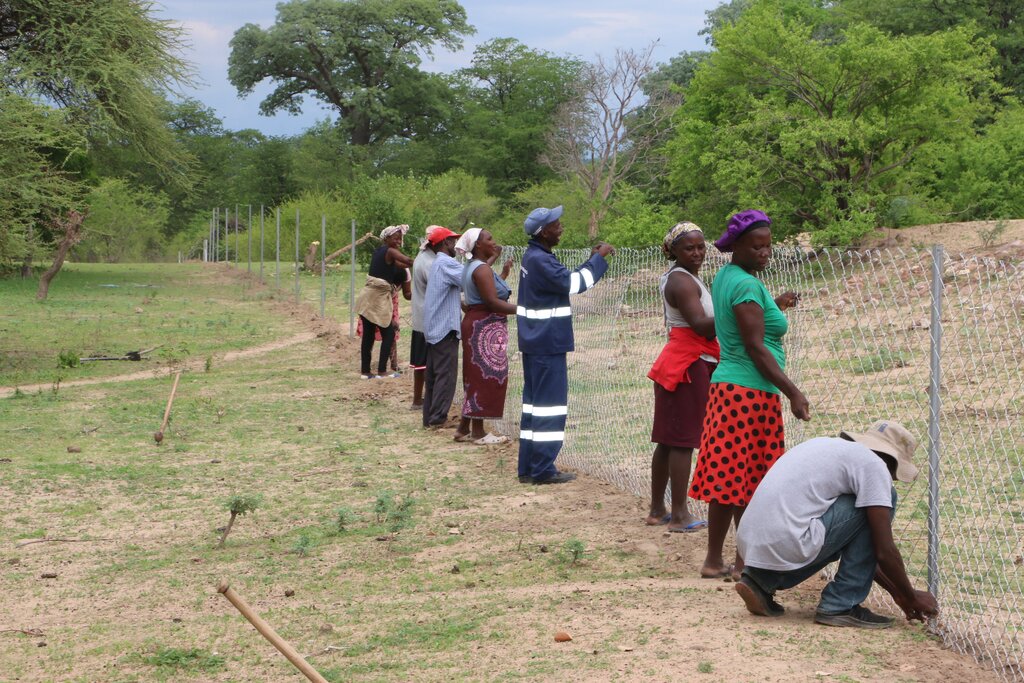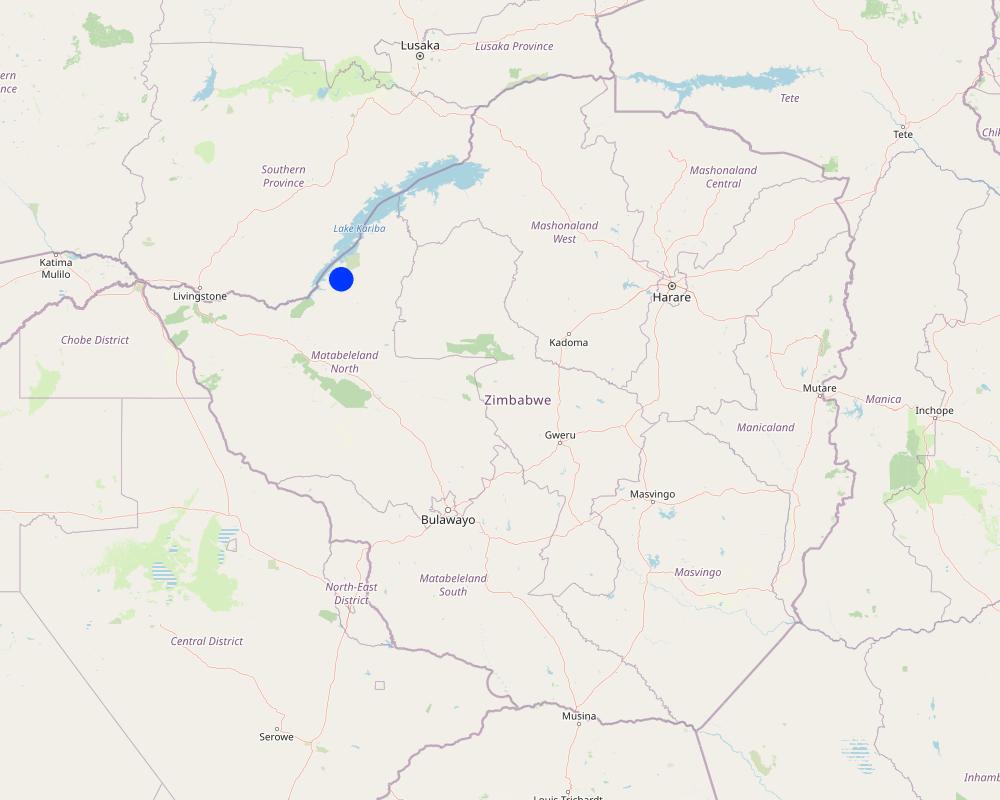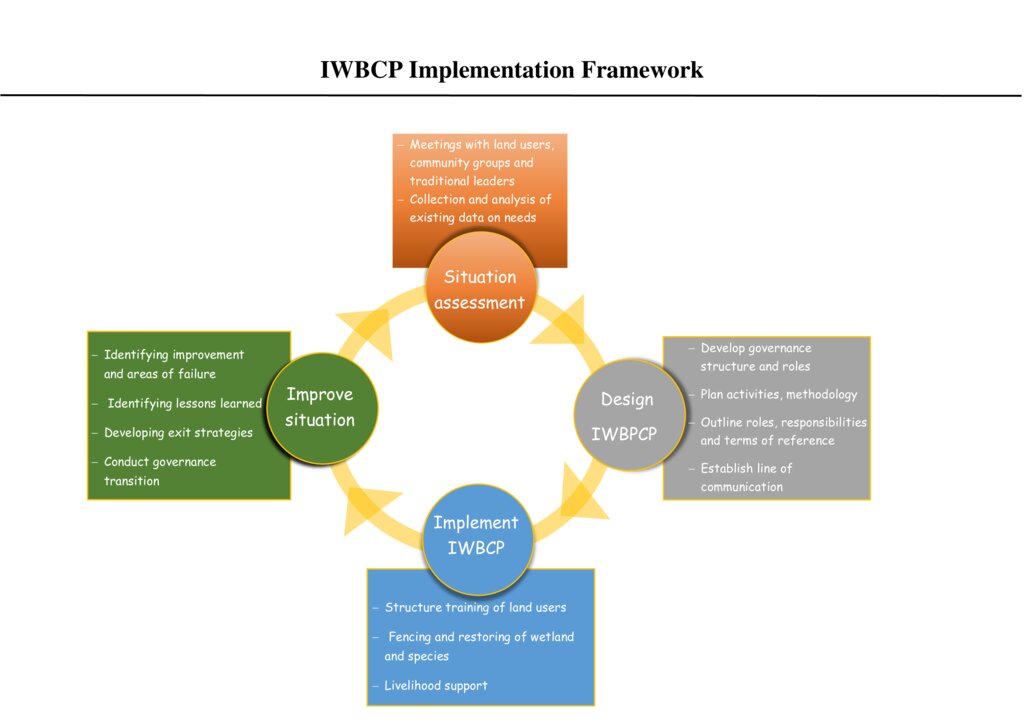Integrated Wetlands Biodiversity Conservation Project [Зимбабве]
- Шинийг нээх:
- Шинэчлэх:
- Эмхэтгэгч: Kalulu Mumpande
- Хянан тохиолдуулагч: –
- Хянагчид: William Critchley, Joana Eichenberger
IWBCP
approaches_7367 - Зимбабве
Бүлгүүдийг үзэх
Бүгдийг дэлгэх Бүгдийг хаах1. Ерөнхий мэдээлэл
1.2 Арга барилыг баримтжуулах болон үнэлгээ хийхэд оролцсон хүн эсвэл байгууллагын холбоо барих хаяг
Мэдээлэл өгсөн хүн(с)
хамтран эмхэтгэгч:
Mumpande Kalulu
+263773667529 / +263773667529
mumpandekalulu@yahoo.com / safesewa@gmail.com
Safe Environment & Wildlife Africa
Stand No. 1659 Medium Density Binga
Зимбабве
ГТМ мэргэжилтэн:
Mumkombwe Jane
+263 773666246 / +263 773666246
katemunkombwe46@gmail.com / katemunkombwe46@gmail.com
Agriculture & Rural Development Advisory Services (ARDAS)
Binga medium Density Stand no// 872 Binga
Зимбабве
Газар ашиглагч:
Susan Mwembe
+263782644815 / +263782644815
Nil / Nil
Smallholder Farmer
Manjolo Primary School P.O Box 10 Binga
Зимбабве
Газар ашиглагч:
Mudenda Naison
+263771152184 / +263771152184
Nil / Nil
Smallholder Farmer
Manjolo Primary School P.O Box 10 Binga
Зимбабве
Indigenous Knowledge Guardian:
Mwembe Nomai
+263775256810 (Daughter) / +263775256810 (Daughter)
Nil / Nil
Community Elderly
Manjolo Primary School P.O Box 10 Binga
Зимбабве
Арга барилыг баримтжуулах/үнэлэх ажилд дэмжлэг үзүүлсэн байгууллага(ууд)-ын нэр (шаардлагатай бол)
Safe Environment & Wildlife Africa (SEWA)1.3 WOCAT-аар баримтжуулсан өгөгдлийг ашиглахтай холбоотой нөхцөл
Мэдээллийг хэзээ (газар дээр нь) цуглуулсан бэ?
21/10/2024
Эмхэтгэгч болон гол мэдээлэгч хүн(хүмүүс) WOCAT аргачлалаар баримтжуулсан мэдээллийг ашиглахтай холбоотой нөхцлийг хүлээн зөвшөөрсөн:
Тийм
2. ГТМ Арга барилын тодорхойлолт
2.1 Арга барилын товч тодорхойлолт
The integrated wetlands biodiversity conservation project aims to restore wetlands and associated biodiversity. The approach strengthens the resilience of neighbouring marginalized groups to climate change through developing lifelong skills and providing livelihoods support.
2.2 Арга барилын дэлгэрэнгүй тодорхойлолт
Арга барилын дэлгэрэнгүй тодорхойлолт:
The Integrated Wetlands Biodiversity Conservation Project aims to restore wetlands and associated biodiversity. It is a 2-year project which started in June 2023 with the support of a USD 50,000.00 grant from the Global Environment Facility Small Grants Programme, implemented by the United Nations Development Programme (UNDP-GEFSGP). The approach strengthens the resilience of neighbouring community to climate change through developing lifelong skills and providing livelihood support. It targets those marginalized groups surrounding protected areas, who experience severe droughts due to high cases of human-wildlife conflicts, making them highly food insecure. The approach is simultaneously improving sustainable management and utilization of the Masibinta wetland and its catchment.
Technical activities are targeted at restoring Masibinta wetland’s ecological integrity by protecting the wetland, implementing conservation agriculture in its catchment, reforesting bare land, controlling and reshaping gullies to create small ponds, and removing a bushy invasive species (Ipomoea carnea) while making compost from its leaves and branches. The ponds increase the recharge of the wetland. This helps provide water to the community and at the same time acts as a barrier to soil erosion and epicenters for natural vegetative cover regeneration and biodiversity restoration. Land degradation neutrality is an overall goal.
Specific targets include:
(a) Protection, rehabilitation and conservation of 13 hectares of Masibinta wetlands, as well as reclamation of degraded land in and around the wetland, while increasing the capacity of the community members to conserve biodiversity.
(b) Increasing access of 387 households to adequate and clean water.
(c) Reduction of invasive species in the wetlands by 80%, and reclamation of 1000 m of gullies.
(d) Promotion of sustainable use and management of Masibinta wetland through regenerative agriculture, livelihood support and imparting lifelong skills to 50 youths (30 females and 20 males).
A variety of technical and social methods are employed:
(a) Grey and Green Infrastructure (GGI): hybrid restoration techniques that involve the combination of engineered structures and Nature-based Solutions (NbS).
(b) Regenerative agriculture: including mulching, mixed cultivation, crop rotation, agroforestry, use of organic manure in nutrition gardens, and zero tillage (“Maganko”).
(c) Incentives: monetary incentives to the community members who offer their labour.
(d) Self-mobilization.
(e) Peer-to-peer learning.
(f) Problem-solving.
The stages of implementation involved are:
(a) Baseline survey,
(b) Education and training of project support staff, stakeholders,
(c) Monitoring, Evaluation and Learning (MEL),
(d) Livelihood support,
(e) Protection of the wetland, then MEL,
(f) Borehole Drilling,
(g) Invasive species management, then MEL,
(h) Gully modification, and
(i) Evaluation and Learning.
The stakeholders involved and their roles are:
(a) Environmental Management Agency (EMA): Implement and monitor restoration activities in the wetland and assess the impact of barricading the gully on the environment.
(b) Forestry Commission (FC): Nursery establishment, management and tree planting.
(c) Agriculture and Rural Advisory Services (ARDAS): Train farmers on agroforestry, goat rearing, climate-smart agriculture, gully reclamation, and polyculture.
(d) Rural and Infrastructure Development Agency (RIDA): oversees all engineering work.
(e) Ministry of Youth Empowerment Development and Vocational Training (MYEDVT): Monitoring youth engagement and benefits.
(f) Ministry of Women Affairs Community Small and Medium Enterprises Development (MWACSMED): Tracked and monitored inclusion and entrepreneurship.
(h) United Nations Development Programme – Grant disbursement, monitoring and evaluating the implementation and sustainability of IWBCP at the national level in line with the GEFSGP expectations.
2.3 Арга барилын зурагууд
2.4 Арга барилын бичлэгүүд
Огноо:
02/02/2024
Байршил:
Manjolo
Зураглаачийн нэр:
Kalulu Mumpande
2.5 Арга барил нэвтрүүлсэн улс орон / бүс нутаг / байршил
Улс:
Зимбабве
Улс/аймаг/сум:
Matebeleland North
Байршлын дэлгэрэнгүй тодорхойлолт:
Binga
Тайлбар:
Masibinta wetland, surrounded by bare catchment areas
Map
×2.6 Арга барилыг эхлэх, дуусах огноо
Эхлэх жилийг тэмдэглэ:
2023
Хэрэв арга барилыг хэрэгжүүлэх жил тодорхойгүй бол ойролцоогоор эхлэх огноог зааж өгнө үү:
<10 жилийн өмнө (саяхны)
Хугацаа дуусах жил (Хэрэв арга барил удаанаар ашиглаагүй бол):
2025
2.7 Арга барилын төрөл
- төсөл / хөтөлбөр дээр үндэслэсэн
2.8 Арга барилын үндсэн зорилго, зорилтууд
The Approach aimed at developing an environmentally responsive community, capable of managing and utilizing Masibinta Wetland most sustainably through:
(a)Increasing knowledge and skills in restoring degraded and conserving the restored land
(b)Improving perceptions on biodiversity and building best practices which promote sustainability of the natural resources capital
(c)Increasing conservation benefit sharing and improving governance of the natural resources
2.9 Арга барилын хүрээнд хэрэгжсэн Технологи/Технологиудад дэмжсэн эсвэл саад учруулсан нөхцлүүд
талуудыг хамтын ажиллагаа/зохицуулалт
- Идэвхижүүлэх
Collaboration between the stakeholder and the community enabled the Approach to win a Provincial Award: Excellence in Biodiversity Restoration and Social Impact.
Хууль, эрхзүйн хүрээ (газар эзэмшил, газар, ус ашиглах эрх)
- Хазаарлалт
Land is owned along family lines which make it difficult to restore. For example a 100-meters portion of a gully which was reclaimed was later cleared to paved a way for a garden by the family member.
Бодлогууд
- Хазаарлалт
Lack of policy on conservation cultivation
ГТМ-ийн талаарх мэдлэг, техникийн дэмжлэг авах боломж
- Хазаарлалт
The stakeholders have limited knowledge on disaster risk reduction and regenerative farming
зах зээл (материал худалдан авах, бүтээгдэхүүн борлуулах), үнэ
- Хазаарлалт
Limited access to markets which offers competitive prices for the landers as producers.
ажлын багтаамж, хүн хүчний нөөц бололцоо
- Хазаарлалт
The work load is huge and the manpower is limited. The support staff were on a voluntary contract.
3. Оролцогч талуудын оролцоо ба үүргүүд
3.1 Арга барилд оролцогч талууд болон тэдгээрийн үүргүүд
- Орон нутгийн газар ашиглагч / орон нутгийн иргэд
Traditional leaders and community members
Community members provided labour and security of materials and food during the Approach's activities. They also monitored and evaluated the Approach and provided valuable lessons. Traditional leadership provided the approach's local oversight role, whipped members into line, provided Indigenous knowledge, and guided the implementation process in accordance with the values and beliefs of the Manjolo community. Traditional leadership was key in information dissemination and resolution of issues which would otherwise affect the success of the Approach
- ГТМ-ийн мэргэжилтэн/ хөдөө аж ахуйн зөвлөх
Agriculture & Rural Development Advisory Services (ARDAS), ZimParks, Forest Commission, Environmental Management Agency (EMA), Small to Medium Enterprises, Ministry of Youth, Social Development, Ministry of Information, Ministry of Health and Child Welfare
Provided technical support, training community members, and local management committees. Supervising activities and evaluating the Approach
- Орон нутгийн захиргаа
Binga District Development Committee
Monitoring and Evaluation of the Approach
Providing supportive framework and ensuring that the Approach keep in line with the district's development agenda
Хэрэв хэд хэдэн оролцогч талууд оролцсон бол голлох төлөөлөгчийг зааж өгнө үү:
Environment Management Agency (EMA) and Agriculture & Rural Development Advisory Services (ARDAS)
3.2 Арга барилын янз бүрийн үе шатанд орон нутгийн газар ашиглагчид / бүлэглэлүүдийг татан оролцуулах
| Орон нутгийн газар ашиглагч / орон нутгийн иргэдийн оролцоо | Хэн оролцсоныг тодорхойлж, үйл ажиллагааг тайлбарлана уу | |
|---|---|---|
| санаачлага/идэвхжүүлэлт | өөрийн хүчийг нэгтгэсэн | Smallholder farmers The initiation began in October 2022 where the organized a meeting and invited SEWA. At this meeting the farmer highlighted the degradation of Masibinta wetland and how the degradation was negatively affecting their lives. The farmers gave suggestion on possible solutions to the challenges faced. |
| Төлөвлөгөө | интерактив | Smallholder farmers, youth, traditional leaders, local business community, church leaders, teachers, Rural Care Givers, Health Workers, Resources Monitors, Counsellors, People with Disability In December 2022, the farmers who initiated the Approach mobilized community members to a planning meetings, developed activities, pledged own contribution to the Approach, outlined roles of each social group in the Approach, developed ways of mobilizing locally available materials and selected management committees and local lines of communication. They also identified potential challenges and suggested ways of dealing with the challenges that could otherwise arise from the Approach |
| Хэрэгжилт | интерактив | The smallholder farmers, traditional leaders, local business community, youth, church leaders, teachers, Rural Care Givers, Health Workers, Resources Monitors, Counsellors, People with Disability The implementation started in July 2023 after GEFSGP had supported the Approach with a grant of $50,000.00 through the UNDP. The community members worked together and provided labour and security of materials and food during the Approach's activities. They also monitored and evaluated the Approach and provided valuable lessons. Traditional leadership provided the approach's local oversight role, whipped members into line, provided Indigenous knowledge, and guided the implementation process in accordance with the values and beliefs of the Manjolo community. Traditional leadership was key in information dissemination and resolution of issues which would otherwise affect the success of the Approach |
| Мониторинг/ үнэлгээ | интерактив | Small holder farmers, youth, traditional leaders, local business community, church leaders, teachers, Rural Care Givers, Health Workers, Resources Monitors, Counsellors, and People with Disability, These provided the views on how the Approach impacted their lives and also on what needed to be changed. |
3.3 Диаграм (хэрэв боломжтой бол)
Тодорхойлолт:
Integrated Wetland Biodiversity Conservation Project (IWBCP) Implementation framework
Зохиогч:
Mumpande Kalulu
3.4 ГТМ-ийн технологи/технологиуд сонгох шийдвэр
Хэрэгжүүлэх Технологи/Технологиудын сонголтыг хийж шийдвэр гаргасан хүнийг тодорхойлно уу:
- оролцооны зарчмын хэсэг болох бүх холбогдох талууд
Шийдвэрийг юунд үндэслэн гаргасан:
- Хувь хүний туршлага ба санал бодол (баримтжуулаагүй)
4. Техникийн дэмжлэг, чадавхи бүрдүүлэх, мэдлэгийн менежмент
4.1 Чадавхи бэхжүүлэх/сургалт
Газар эзэмшигчид / бусад оролцогч талуудад сургалт явуулсан уу?
Тийм
Хэрэв шаардлагатай бол хүйс, нас, яс үндэс, гэх мэт. нэмнэ үү:
124 smallholder farmers (69 females, 55 males), 10 Village Heads (2 females, 11males), and 2 Ward-based Environment Monitors (all males) were capacity developed from the 32 hours structured training on land and biodiversity restoration and conservation. During the training the participants were engaged through presentations, drama, role plays, scenarios, problem-solving and field trips. The key stakeholders drawn from government line ministries, and Binga Rural District Council trained the the beneficiaries.
Сургалтын хэлбэр:
- Ажил дээр
- фермерээс -фермер
- Олон нийтийн уулзалт
Хамрагдсан сэвдүүд:
Biodiversity conservation, project infrastructure management, sustainable land management, agroforestry, gully reclamation, conservation farming, climate change, and environmental policies
Тайлбар:
The training sessions were not enough due to limited budget. Each training was conducted conducted over for 8hrs and the participants had little time for hands-on participation.
4.2 Зөвлөх үйлчилгээ
Газар ашиглагчдад зөвлөх үйлчилгээ авах боломжтой байдаг уу?
Тийм
Зөвлөх үйлчилгээ үзүүлсэн эсэхийг тогтоо:
- Газар ашиглагчийн талбай дээр
- Тогтмол төвд
Тодорхойлолт / тайлбар:
The Rural & Infrastrure Development Agency , Forest Commission and Agriculture & Rural Development Advisory Services provided advisory services to land users crop fields preparation, gully reclamation, tree planting, and wetland management
4.3 Институцийг бэхжүүлэх (байгууллагын хөгжил)
Арга барилаар дамжуулан институц байгуулагдаж эсвэл бэхжсэн үү?
- Тийм, дунд зэрэг
Байгууллагууд бэхжиж, үүсэн бий болсон түвшин(үүд)-г тодорхойлно уу:
- Орон нутгийн
Байгууллага, үүрэг, хариуцлага, гишүүд гэх мэтийг тайлбарлах:
Community Management Committee and local constitution
Supervision of the land users and enforcing constitution
Дэмжлэгийн төрлийг ялга:
- чадавхи бэхжүүлэх / сургалт
Дэлгэрэнгүй мэдээллийг өгнө үү:
The management committee was trained once on their roles. However, more structured training would enhance their discharge of duties
4.4 Мониторинг ба үнэлгээ
Мониторинг болон үнэлгээ нь арга барилын хэсэг үү?
Тийм
Тайлбар:
Continuous monitoring was carried out by the Approach support staff. Monitoring and Evaluation was done quarterly, involving all key stakeholders
Хэрэв тийм бол энэ баримт бичиг нь мониторинг, үнэлгээнд ашиглагдахаар зориулагдсан уу?
Үгүй
4.5 Судалгаа
Судалгаа арга барилын хэсэг нь байсан уу?
Үгүй
5. Санхүүгийн болон гадаад материаллаг дэмжлэг
5.1 ГТМ-ийн Арга барилын бүрэлдэхүүн хэсгийн жилийн төсөв
Арга барил дахь ГТМ-ийн бүрэлдэхүүн хэсгийн жилийн төсвийг ам.доллараар харуулна уу:
25000.00
Тайлбар (жнь: санхүүжилтийн гол эх үүсвэр / гол хандивлагчид):
-Co-funding
-Global Environment Facility Small Grants Programme, implemented by the United Nations Development Programme (UNDP_GEFSGP)
5.2 Газар ашиглагчдад санхүүгийн / материаллаг дэмжлэг үзүүлсэн
Технологи / технологийг хэрэгжүүлэхэд газар ашиглагчид санхүүгийн / материаллаг дэмжлэг авсан уу?
Тийм
Хэрэв тийм бол дэмжлэгийн төрөл(үүд), нөхцөл, болон нийлүүлэгч(чид) бичнэ үү:
Fencing materials, stationary, cement, goats, seed inputs
Provider: UNDP_GEFSGP
5.3 Тодорхой зардлыг даахад чиглэсэн дэмжлэгт (хөдөлмөрийн хүчийг оролцуулаад)
- Тоног төхөөрөмж
| Ямар хөрөнгө оруулалт татаасаар олгогдсоныг заана уу | Ямар талбайн хэмжээнд | Тэтгэмж, урамшууллыг тодорхойлно уу |
|---|---|---|
| Багажууд | хэсэгчлэн санхүүждэг | |
| Fencing material | Бүрэн санхүүждэг | |
- Хөдөө аж ахуй
| Ямар хөрөнгө оруулалт татаасаар олгогдсоныг заана уу | Ямар талбайн хэмжээнд | Тэтгэмж, урамшууллыг тодорхойлно уу |
|---|---|---|
| Үр, үрсэлгээ | хэсэгчлэн санхүүждэг | |
- Дэд бүтэц
| Ямар хөрөнгө оруулалт татаасаар олгогдсоныг заана уу | Ямар талбайн хэмжээнд | Тэтгэмж, урамшууллыг тодорхойлно уу |
|---|---|---|
| Fence | Бүрэн санхүүждэг | |
Хэрэв газар ашиглагчийн хөдөлмөрийн хүч чухал байсан бол энэ нь аль хэлбэр байсан:
- сайн дурын
Тайлбар:
The land user provided voluntary work during the fencing of the wetland. An additional funding of $15,000.00 for the management of the Ipomoea carnea and gully medication has been secured from he G20 Global Land Restoration Initiative. Under these activities, the land users will be provided and an incentive of $1.50 per day per individual for the provision of labour. The activities are yet to be implemented once the funds are disbursement into SEWA's bank account.
5.4 Кредит
Арга барилын хүрээнд ГТМ-ийн үйл ажиллагаанд зориулж зээлд хамрагдсан уу?
Үгүй
5.5 Бусад урамшуулал, хэрэгсэл
ГТМ-ийн технологийг хэрэгжилтийг дэмжихэд ашигласан бусад урамшуулал, хэрэгсэл байсан уу?
Тийм
Хэрэв тийм бол, тодруулна уу:
Monetary incentive (for activities which are yet to be done using the additional support from the G20 Global Land Restoration Initiative)
6. Нөлөөллийн дүн шинжилгээ ба дүгнэлт
6.1 Арга барилын нөлөөллүүд
Арга барил нь орон нутгийн газар ашиглагчдыг чадваржуулах, оролцогч талуудын оролцоог сайжруулсан уу?
- Үгүй
- Тийм, бага зэрэг
- Тийм, зарим
- Тийм, их
124 land users were trained, supported with seed imputes, and goats.
Арга барил нь нотолгоонд суурилсан шийдвэр гаргах боломж олгосон уу?
- Үгүй
- Тийм, бага зэрэг
- Тийм, зарим
- Тийм, их
Decisions were made based on data gathered from community engagements, lessons learned from the before projects in the area and the surveys conducted as a baseline.
Арга барил нь ГТМ-ийн технологийг хэрэгжүүлж, хадгалахад газар ашиглагчдад тусласан уу?
- Үгүй
- Тийм, бага зэрэг
- Тийм, зарим
- Тийм, их
Land users have reclaimed 100 metres of gullies, implemented conservation cultivation, used nature-based approaches to restore the wetland
Арга барил нь ГТМ-ийн зардал хэмнэсэн хэрэгжилт, зохицуулалтыг сайжруулсан уу?
- Үгүй
- Тийм, бага зэрэг
- Тийм, зарим
- Тийм, их
The use of Nature-based Solutions and indigenous knowledge reduced the cost of implementing the SLM as such approaches are cheaper in terms of cost. Approach improved coordination between the project management and land users through clearly defined roles and lines of communication
Арга барил нь ГТМ-ийн хэрэгжилтийн санхүүгийн эх үүсвэрийн хүртээмжийг сайжруулах / эргэлтэнд оруулахад чиглэсэн үү?
- Үгүй
- Тийм, бага зэрэг
- Тийм, зарим
- Тийм, их
Mobilized finances from the Global Environment Facility Small Grants Programme through the United Nations Development Programme (UNDP-GEFSGP). Finances have also been mobilized from the G20 Global Land Initiative, though yet to be disbursed into SEWA's bank account.
Арга барил нь ГТМ хэрэгжүүлэхэд газар ашиглагчдын мэдлэг, чадварыг сайжруулахад хүргэсэн үү?
- Үгүй
- Тийм, бага зэрэг
- Тийм, зарим
- Тийм, их
124 land users were trained on SLM and were given kowledge material such as brochures.
Энэ арга барил бусад сонирхогч талуудын мэдлэг, чадавхийг сайжруулсан уу?
- Үгүй
- Тийм, бага зэрэг
- Тийм, зарим
- Тийм, их
Not much training of stakeholders was done. However the stakeholders drew lessons from the project and shared their experience during project progress update meetings.
Арга барил нь оролцогч талуудын хооронд институци, хамтын ажиллагааг бий болгож, бэхжүүлсэн үү?
- Үгүй
- Тийм, бага зэрэг
- Тийм, зарим
- Тийм, их
Each and every stakeholder involved in the project had clearly defined roles and synergies
Энэ арга барил зөрчилдөөнийг багасгасан уу?
- Үгүй
- Тийм, бага зэрэг
- Тийм, зарим
- Тийм, их
The fencing of wetland including the nutrition gardens and the development of the land users' constitution mitigated conflicts
Арга барил нь эмзэг бүлгийнхнийг нийгэм, эдийн засгийн хувьд чадавхижуулсан уу?
- Үгүй
- Тийм, бага зэрэг
- Тийм, зарим
- Тийм, их
Assisted women, youth and people with disability with female goats. These groups were trained under the same rood
Арга барил нь газар ашиглагч залуучууд / дараагийн үеийн хүмүүсийг ГТМ-д оролцохыг хөхүүлэн дэмжсэн үү?
- Үгүй
- Тийм, бага зэрэг
- Тийм, зарим
- Тийм, их
Financial limitation reduced the engagement of youth in Manjolo as the effective method of engaging youth in Manjolo require a reasonable budget
Арга барил нь ГТМ-ийн технологийг хэрэгжүүлэхэд саад учруулсан газрын эзэмшил / ашиглах эрхийг сайжруулахад чиглэсэн үү?
- Үгүй
- Тийм, бага зэрэг
- Тийм, зарим
- Тийм, их
The Approach has not yet tackled the issue
Арга барил нь чанаржуулсан шим тэжээл/ хүнсний аюулгүй байдалд хүргэсэн үү?
- Үгүй
- Тийм, бага зэрэг
- Тийм, зарим
- Тийм, их
Through crop yields, and income generation projects.
Арга барил нь зах зээлийн хүртээмжийг сайжруулсан уу?
- Үгүй
- Тийм, бага зэрэг
- Тийм, зарим
- Тийм, их
Local market. Land users are supply Boarding School and a hospital with green vegetables
Арга барил нь ус, ариун цэврийн байгууламжийн хүртээмжийг сайжруулахад хүргэсэн үү?
- Үгүй
- Тийм, бага зэрэг
- Тийм, зарим
- Тийм, их
Boreholes Drilling couldn't find water.
Арга барил нь эрчим хүчний эх үүсвэр/ илүү тогтвортой ашиглалтад хүргэх үү?
- Үгүй
- Тийм, бага зэрэг
- Тийм, зарим
- Тийм, их
The Approach did not look at energy
Арга барил нь газар ашиглагчид уур амьсгалын өөрчлөлтөд дасан зохицох чадварыг дээшлүүлж, уур амьсгалын өөрчлөлттэй холбоотой гамшгийг бууруулах чадавхийг сайжруулсан уу?
- Үгүй
- Тийм, бага зэрэг
- Тийм, зарим
- Тийм, их
Through training and livelihoods support
2 youth were employed for fencing
6.2 ГТМ-ийг хэрэгжүүлэх газар ашиглагчидын гол санаачилга
- үйлдвэрлэл нэмэгдсэн
Improved protection of their crops in nutrition gardens, increased crop production, ownership and management of the wetland.
- Ашиг нэмэгдсэн (боломж), зардал-үр ашгийн харьцаа сайжирсан
81 out of 144 wetland users reported an average increase of 32% from their incomes over the last cropping season. 79 out of 144 reported an average increase of 40 kg of maize production in the last between November 2023 and March 2024. All wetland user reported reduced destruction of their crops by livestock over the past cropping season.
- Газрын доройтол буурсан
67 Farmers adopted the use of organic fertilizers and 23 were involved in the demo plots for poly cropping. The wetland user protected 13 seeps using the reeds. 15 farmers have since abandoned the use of brash wood fencing adopting the edible hedging. These practices have reduced land degradation. However restoration is still ongoing to realize full impact of the Approach.
- Гамшигийн эрсдэл буурсан
89 out 144 households which used to miss at least a meal per day during the drought months (July to February) reported that they never missed a meal between July 2024 and October 2024.
- Ажлын ачаалал бууруулсан
The fencing of wetland has significantly reduced the workload particularly for women and girls who used to spend about 27% of their 24-Hour Day manning their gardens from animals. A 12% decrease in time spend looking after crops has been observed.
- дүрэм журам (торгууль) / сахиулах
As way of improving sustainability of Masibinta wetland, the community have set rule and regulations for the management of the resources. The trespassers are liable to a commensurate fines and the rules are enforces at local level by the Community Management Committee (CMC) and the traditional leadership. The community members participate in the enforcement of the rules through being own police.
- нэр хүнд, нийгмийн дарамт / нийгмийн холбоо
Masibinta Wetland saves support 2400 community members and 3 schools with water, livelihoods and income for feeds and health needs. The restoration of the wetland by the Approach has unified different groups in the community by working and living together for a common cause. It has improved social relationships, pride and reduced poverty
- Сүлжээ/ бүлэг төсөл/ хөдөлгөөнд гишүүнээр элсүүлэх
As a result of the Approach, SEWA has joined the UNCCD and WOCAT Network.
- Байгаль орчны ухамсар
The Land Users have formed the Manjolo Environment Defenders Club (MEDC). The MEDC was formed as community initiative led by women after being educated by the Approach on land restoration and Protection. The club carries out peer-to -peer education on best environmental practices, such as encouraging fellow Land Users to use organic fertilizers, stop cutting of trees, accouraging safe use of wetland and monitoring the wetland health. The club started with 4 women but now the membership has grown to 15. This shows improved environmental consciousness as a result of the Approach
- зан заншил, ёс суртахуун
The Approach has improved the Land Users' awareness of the importance of conserving land resources. This motivated them to explore beyond what they were taught. They now value nature more that before the implementation of the approach.
- ГТМ-ийн мэдлэг, туршлага дээшилсэн
The training reconceived by the Land Users has equipped them with skills to contract gabions, plants trees, raise tree nurseries for commercial purpose. Two of the youth who were trained in fence installation got contracts on fencing. The farmers who were trained on regenerative agriculture, are now practicing on their crop fields.
- гоо зүйн сайжруулалт
The Approach's innovativeness and novelty made to appeal o the Land Users
- зөрчилдөөнийг бууруулах
Conflicts caused by livestock destroying crops in nutritional gardens have been reduced. However due to the improved habitat conditions, crocodiles and pythons have since invaded the wetland and new conflicts have arisen between these species and the farmers. How, SEWA is working with the Community Resources, Communal Areas Management Programmes For Indigenous Resources (CAMPFIRE) and Zimbabwe Parks & Wildlife Management Authority (ZimParks) in monitoring and relocating the crocodiles and pythons.
6.3 Арга барилын үйл ажиллагааны тогтвортой байдал
Газар ашиглагчид арга барилаар дамжуулан хэрэгжүүлсэн арга хэмжээг тогтвортой хадгалж чадах уу (гадны дэмжлэггүйгээр)?
- Тийм
Хэрэв тийм бол яаж гэдгийг тайлбарлана уу:
In terms of human sustainability, the training that the Land Users have received, skills and knowledge that they have gained will enable them to continue with the project activities without any external support. The involvement of the Land Users in decision making structures and programmes will enable Land Users to make and implement key decisions beyond the external support. The income generating projects and the Internal Savings and Lending Schemes introduced under the Approach will ensure financial sustainability. The training of the stakeholders by the Approach provide the technical sustainability.
6.4 Арга барилын тогтвортой/давуу тал/боломжууд
| Газар ашиглагчдын тодорхойлсон давуу тал/боломжууд |
|---|
| The Approach is providing women with financial independence and choices. |
| The Approach is empowering the marginalized community groups with climate resilient and bankable assets. For example 12 youth, 3 people with disability and 10 women have been assisted with 2 female goats, increasing conservation benefits. |
| The land Users view the Approach as their out of hunger and poverty |
| Эмхэтгэгч, бусад мэдээлэл өгсөн хүмүүсийн өнцгөөс тодорхойлсон давуу тал/боломжууд |
|---|
| Views the Approach as sustaible and transformative development. |
| The Approach is viewed as practical demonstration of sustainable land management |
| Viewed as a sources of lessons for the partners and environmentalists |
6.5 Арга барилын дутагдалтай/сул тал/аюул болон тэдгээрийн хэрхэн даван туулах арга замууд
| Газар ашиглагч нарын тодорхойлсон сул тал/ дутагдал/ эрсдэл | Тэдгээрийг хэрхэн даван туулах вэ? |
|---|---|
| The Approach has a limited thrust on influencing policy and land tenure | Involving policy makers at local level |
| The Approach has not identified learning areas | Identify learning areas through monitoring and evaluation sessions |
| Эмхэтгэгч, бусад мэдээлэл өгсөн хүмүүсийн өнцгөөс тодорхойлсон сул тал/ дутагдал/ эрсдэл | Тэдгээрийг хэрхэн даван туулах вэ? |
|---|---|
| The ponds may cause risk of drowning of children as kids love playing in water | Constructing shallow ponds |
7. Суурь мэдээлэл болон холбоосууд
7.1 Мэдээллийн эх үүсвэр/аргууд
- Хээрийн уулзалт, судалгаа
24
- Газар ашиглагчтай хийсэн ярилцлага
6
- ГТМ-ийн мэргэжилтэн/шинжээчтэй хийсэн ярилцлага
1
7.2 Холбогдох бүтээлийн ишлэл
Гарчиг, зохиогч, он, ISBN:
None
7.3 Холбогдох мэдээллийн интернет дэх нээлттэй холбоосууд
Гарчиг/ тодорхойлолт:
None
Холбоос ба модулууд
Бүгдийг дэлгэх Бүгдийг хаахХолбоосууд
Холбоос байхгүй байна
Модулууд
Модуль байхгүй байна


